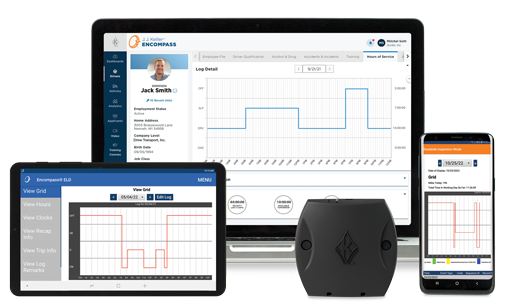Sr. Industry Business Advisor — J. J. Keller & Associates, Inc.
Who Is Responsible for ELD Compliance?
One error carriers sometimes make is using the broad statement that “Hours of Service compliance is everyone’s responsibility.”
Published On: 01/27/2017


Written by:
Tom Bray
As part of your transition from paper logs to ELogs, it’ll be critical to assign specific operational responsibilities when it comes to Hours of Service compliance. One error carriers sometimes make is using the broad statement that “Hours of Service compliance is everyone’s responsibility.” While that may be true, no one will be held accountable for specific issues unless specific responsibilities are assigned.
During the transition to ELogs, the impact of assigned responsibilities may be severely tested. You’ll need to watch for micromanagers, passive managers, and policies that are confusing, contradictory or just plain ignored. Now, let’s look at assigning responsibilities to upper management, driver supervisors, and drivers so your company can enjoy a smoother transition to ELogs.
ELD Compliance and Upper Management
Specific Hours of Service responsibilities must be delegated by upper management because Hours of Service, while regulated by the FMCSA, is also an operational issue because of its impact on driver availability, dispatch, and your ability to deliver superior customer service. After all, Hours of Service impacts the bottom line. It’s also important to note that when upper management delegates decision-making authority, the rights and responsibilities that go along with a task or decision must also be delegated.
One concept that needs to accompany delegation is accountability. If an individual within a specific personnel group is delegated an Hours of Service responsibility, that individual must be held accountable for the outcome by upper management. This ensures that the Hours of Service policies and procedures are being followed consistently and fairly.
Examples of upper management responsibilities include:
- Developing, implementing, and updating Hours of Service policies
- Ensuring that those policies are being followed and enforced
ELD Compliance and Safety Personnel and Driver Supervisors
For safety personnel and driver supervisors, taking responsibility for compliance can be frustrating if they’re told by upper management that they need to “make their own decisions,” yet are dealing with management that questions all decisions made, or if they haven’t been delegated the authority necessary to affect the outcome. An easy indicator that a task is being micromanaged is if every decision made according to established policies is either being questioned or made by the supervisor’s manager. This situation must be rectified before real progress can made.
However, even with an ideal execution of Hours of Service policies, improvements in compliance won’t happen overnight. The planning and organizing of activities that will achieve significant results take time and commitment from all levels of the company. The longer an organization takes to conform to its policies and procedures, the longer it will continue to pay for deviations.
Examples of safety personnel responsibilities include:
- Training drivers and driver supervisors on the Hours of Service regulations and your company’s policies
- Counseling and correcting drivers when violations are discovered
Examples of driver supervisor responsibilities include:
- Adjusting assignments as necessary to ensure drivers comply with the Hours of Service limits
- Making sure drivers are complying with the Hours of Service regulations and your policies
ELD Compliance and Drivers
Most drivers are familiar with the Hours of Service regulations and are equally familiar with how to “bend” the rules in order to meet shipper and management demands. Creating a non-negotiable Hours of Service policy with specific expectations and clearly communicated consequences for violating them will create a culture shift in fleets that previously had a lax Hours of Service compliance program.
Examples of driver responsibilities include:
- Complying with the Hours of Service regulations and related company policies
- Correcting behaviors he/she has been counseled on
If you anticipate significant resistance to ELogs, consider creating opportunities for driver involvement during all phases of the transition. Simply asking a driver “What do you think?” or “What else should we cover here?” might be all that’s needed to get buy-in. Increasing driver involvement offers many advantages over traditional management practices, such as:
- Replacing adversarial driver/management relationships with trust, cooperation, and mutual respect
- Increasing driver enthusiasm for your safety values, goals, policies, and commitment to the organization
- Empowering drivers to make daily decisions and solve problems immediately, which in turn enhances operational efficiency
- Increasing overall driver job performance, safety, and retention
Creating more driver involvement takes time, but the long-term return on this investment — reduced driver turnover and better adherence to ELD company policies — will be paid back many times over.
You may also enjoy the following articles:
Sign up for our newsletter!
We'll help you stay on top of regulations, best practices, and fleet industry news. Sign up to receive a monthly email notification with links to our most recent blog articles, free resources, and event invites.
